A charged particle moves in a uniform electric field. Getting into electric and magnetic fields, charged particles are under the action of Lorentz forces and change their initial motion.
Let a particle of mass m and charge e flies with speed v into the electric field of a flat capacitor. The length of the capacitor is x, the field strength is E. Moving upward in the electric field, the electron will fly through the capacitor along a curved path and fly out of it, deviating from the original direction by y. Under the action of the field force, F=eE=ma, the particle moves with acceleration along the vertical, therefore
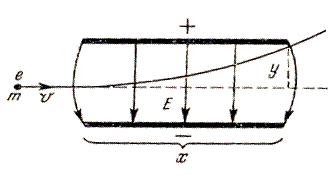
The time of particle movement along the x-axis with a constant speed. Then ![]() . And this is the equation of a parabola. That. A charged particle moves in an electric field along a parabola.
. And this is the equation of a parabola. That. A charged particle moves in an electric field along a parabola.
3. Particle in a magnetic field Consider the motion of a charged particle in a magnetic field of strength H. The field lines are shown as dots and are directed perpendicular to the plane of the figure (to us).
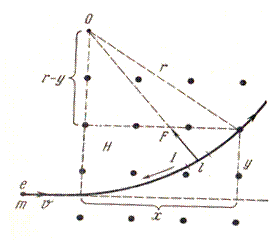
A moving charged particle is electricity. Therefore, the magnetic field deflects the particle upward from its original direction of motion (the direction of motion of the electron is opposite to the direction of the current)
According to the Ampère formula, the force that deflects a particle in any part of the trajectory is
Current, where t is the time for which the charge e passes through the section l. That's why
Considering that , we get
The force F is called the Lorentz force. Directions F, v and H are mutually perpendicular. The F direction can be determined by the left hand rule.
Being perpendicular to the velocity , the Lorentz force only changes the direction of the particle's velocity, without changing the magnitude of this velocity. From this it follows that:
1. The work of the Lorentz force is zero, i.e. a constant magnetic field does no work on a charged particle moving in it (does not change the kinetic energy of the particle)
Recall that, unlike a magnetic field, an electric field changes the energy and velocity of a moving particle.
2. The trajectory of a particle is a circle on which the particle is held by the Lorentz force, which plays the role of a centripetal force.
The radius r of this circle is determined by equating the Lorentz and centripetal forces:
That. the radius of the circle along which the particle moves is proportional to the speed of the particle and inversely proportional to the strength of the magnetic field.
The period of revolution of the particle T is equal to the ratio of the circumference S to the speed of the particle v:6
Taking into account the expression for r, we obtain Therefore, the period of revolution of a particle in a magnetic field does not depend on its speed.
If a magnetic field is created in the space where a charged particle moves, directed at an angle to its velocity, then the further movement of the particle will be the geometric sum of two simultaneous movements: rotation around a circle with a speed in a plane perpendicular to lines of force, and moving along the field with a speed . It is obvious that the resulting trajectory of the particle will be a helix
. 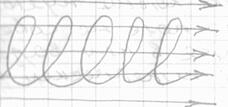
4. Electromagnetic blood velocity counters
The principle of operation of an electromagnetic meter is based on movement electric charges in a magnetic field. In the blood there is a significant amount of electrical charges in the form of ions.
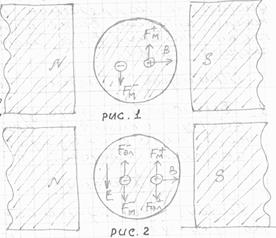
Let us assume that a certain number of singly charged ions move inside the artery with a speed . If an artery is placed between the poles of a magnet, the ions will move in the magnetic field.
For the directions and B shown in Fig.1, the magnetic force acting on positively charged ions is directed upwards, and the force acting on negatively charged ions is directed downwards. Under the influence of these forces, the ions move towards opposite walls of the artery. This polarization of arterial ions creates a field E (Fig. 2) equivalent to uniform field flat capacitor. Then the potential difference in the artery U (whose diameter is d) is related to E by the formula
It was experimentally found that the electron beam emitted by the cathode tube is deflected in an external magnetic field. The deflection direction is perpendicular to the induction vector and the vector  speed of the ordered movement of electrons. Thus, a force acts on charges moving in a magnetic field, the direction of which coincides with the direction of the vector product
speed of the ordered movement of electrons. Thus, a force acts on charges moving in a magnetic field, the direction of which coincides with the direction of the vector product 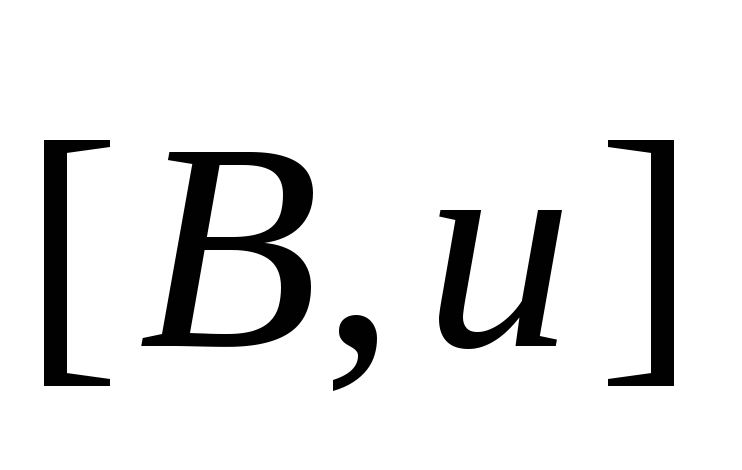 , if the particles are negatively charged, or
, if the particles are negatively charged, or 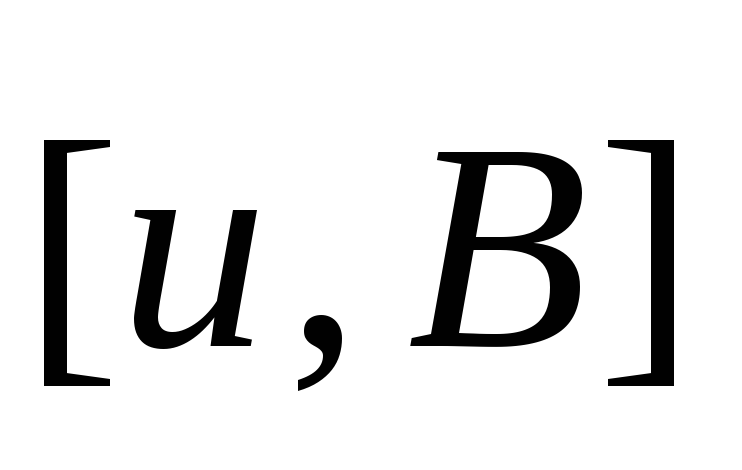 if the particles are positively charged.
if the particles are positively charged.
Let us determine the force acting on an electric charge moving in a magnetic field. According to Ampère's law per element 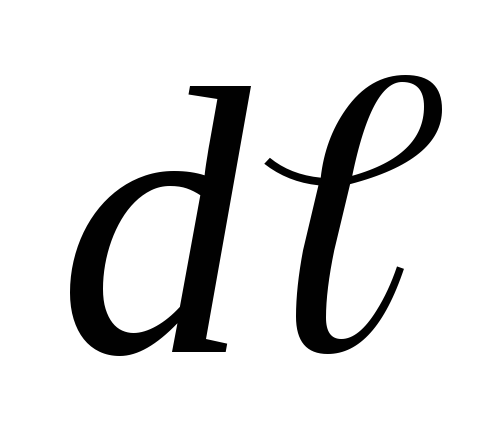 conductor with current I, the force acts
conductor with current I, the force acts
The current in the conductor is determined by the movement of charges that move at a speed  :
: , where dn
- number of particles in the conductor element
, where dn
- number of particles in the conductor element 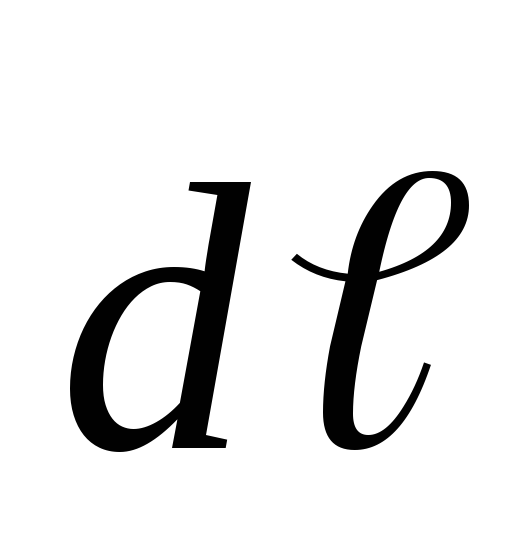 ,.
,.
Let's define the force acting on one charge:
 -
-
This is the Lorentz force. Direction 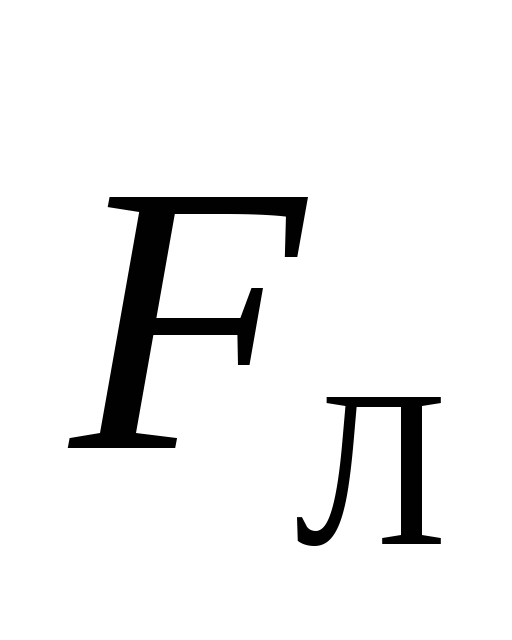 determined by the sign of the charge q. The Lorentz force is always directed perpendicular to the velocity of the charge and plays the role of a centripetal force. The Lorentz force does no work. It only changes the direction of the charge's velocity in a magnetic field. The absolute value of the charge velocity and its kinetic energy do not change when moving in a magnetic field
determined by the sign of the charge q. The Lorentz force is always directed perpendicular to the velocity of the charge and plays the role of a centripetal force. The Lorentz force does no work. It only changes the direction of the charge's velocity in a magnetic field. The absolute value of the charge velocity and its kinetic energy do not change when moving in a magnetic field
 .
.
But the invariance of the velocity and kinetic energy of a charged particle takes place only in the case of a constant magnetic field that does not depend on time, i.e. stationary. A variable magnetic field accelerates charged particles (i.e. changes the magnitude and direction of the velocity).
Consider the motion of a particle in a uniform magnetic field. We will assume that no electric fields act on the particle.

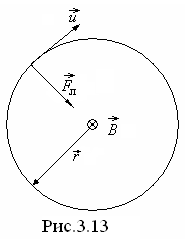
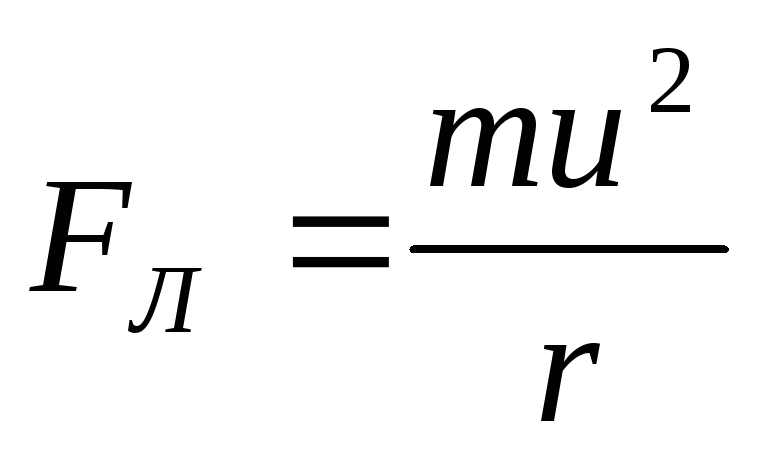 ,
,
where m is the mass of the charged particle , r is the radius of curvature of its trajectory. Let's find r:
 .
.
The speed of the particle does not change, induction  =
const, means, r=
const,
and the charged particle will move in a circle whose plane is perpendicular to the magnetic field.
=
const, means, r=
const,
and the charged particle will move in a circle whose plane is perpendicular to the magnetic field.
Direction of the Lorentz force 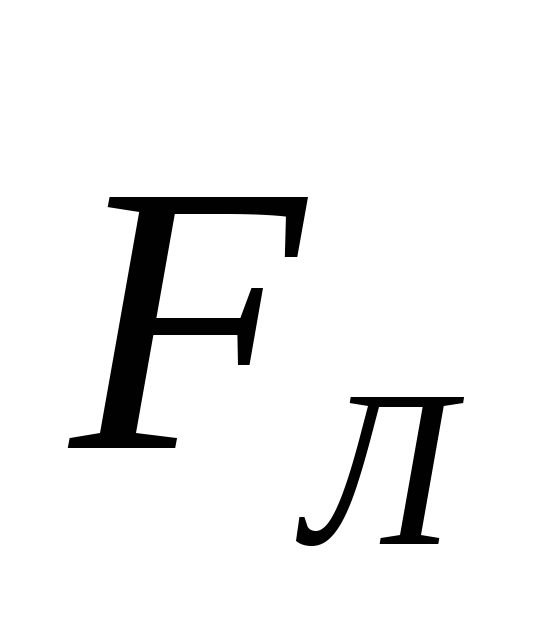 and the direction of the deflection of a charged particle caused by it in a magnetic field depends on the sign of the charge q. Therefore, the sign of the charge can be judged from the direction of deflection.
and the direction of the deflection of a charged particle caused by it in a magnetic field depends on the sign of the charge q. Therefore, the sign of the charge can be judged from the direction of deflection.
A particle moves in a magnetic field along a circle of radius r evenly. Period of circulation, i.e. time for one full turn:

- the period of revolution of a particle does not depend on its speed. This period is directly proportional to the magnetic field induction.
the period of revolution of a particle does not depend on its speed. This period is directly proportional to the magnetic field induction.

Parallel to the vector  -
-
 and perpendicular to
and perpendicular to  -
- :
:
Speed  does not change in a magnetic field, this is the speed of the translational motion of the particle. Thanks to the speed
does not change in a magnetic field, this is the speed of the translational motion of the particle. Thanks to the speed  particle moves in a circle in a plane perpendicular to
particle moves in a circle in a plane perpendicular to  , then the radius of this circle:
, then the radius of this circle:
 .
.
Thus, the particle simultaneously performs two motions - translational with a speed  in the direction of the field, i.e. perpendicular to the speed of rotation, and rotational
in the direction of the field, i.e. perpendicular to the speed of rotation, and rotational  . In this case, the trajectory of motion will be a helical line, the axis of which coincides with the magnetic field induction line, the radius of the turns
. In this case, the trajectory of motion will be a helical line, the axis of which coincides with the magnetic field induction line, the radius of the turns
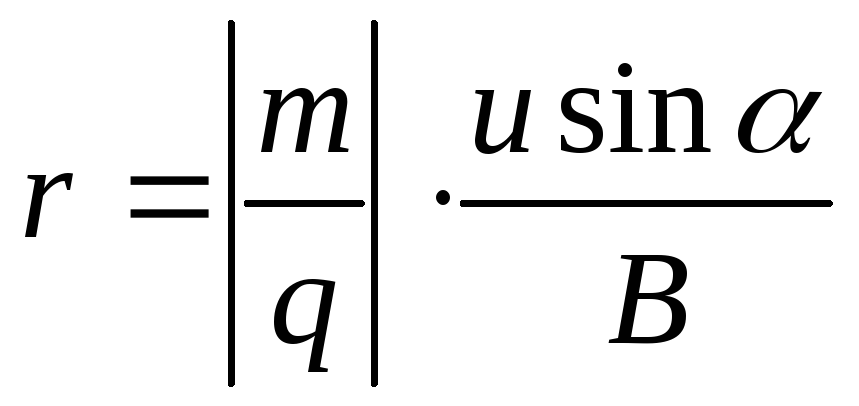 .
.
Screw pitch  .
.
Consider the motion of charged particles in electric and magnetic fields. Let a narrow beam of identical charged particles (for example, electrons) hit the point O
on a screen perpendicular to it (Fig. 3.15). Let us determine the displacement of the beam trace caused by a uniform electric field perpendicular to the beam, acting on a path of length 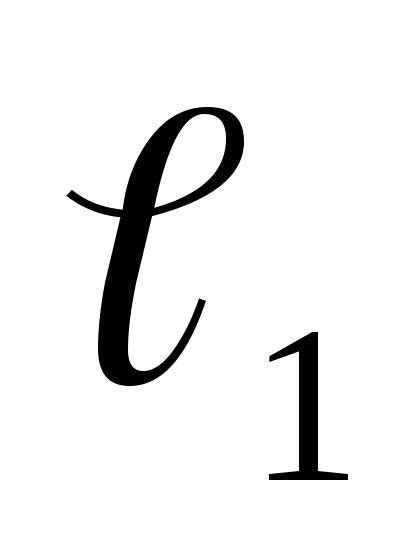 . P
. P  let the initial speed of the particle is equal to
let the initial speed of the particle is equal to  . Entering the field region, each particle will move with a constant magnitude and direction, perpendicular to
. Entering the field region, each particle will move with a constant magnitude and direction, perpendicular to  acceleration
acceleration 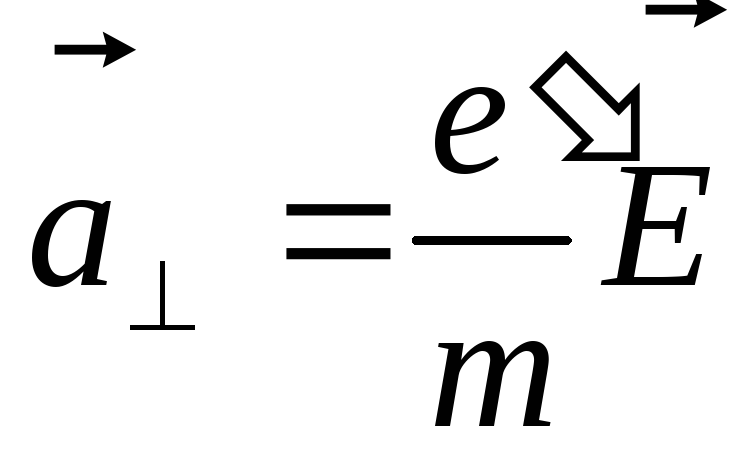 (e"/
m is the specific charge of the particle). Movement under the action of the field continues time
(e"/
m is the specific charge of the particle). Movement under the action of the field continues time 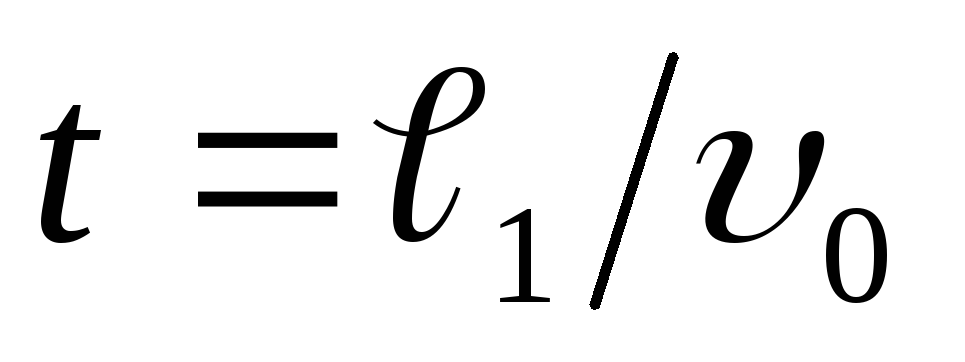 . During this time, the particles will move a distance
. During this time, the particles will move a distance  and acquire perpendicular to
and acquire perpendicular to  speed component
speed component  . In the future, the particles fly in a straight line in the direction that forms with the vector
. In the future, the particles fly in a straight line in the direction that forms with the vector  corner
corner  , determined by the condition
, determined by the condition 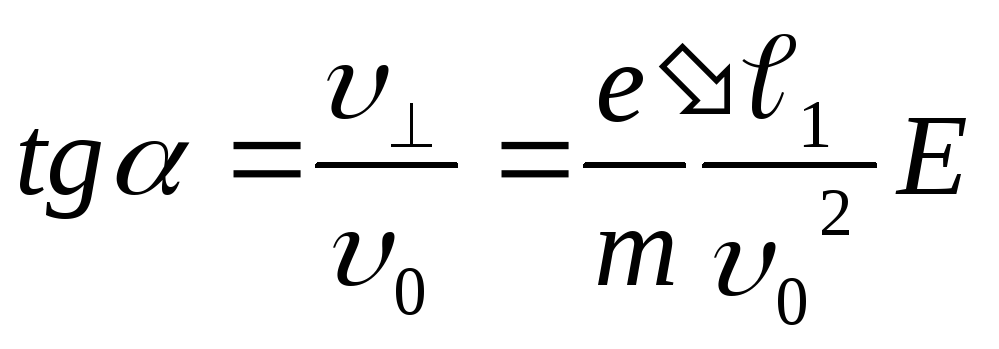 . As a result, in addition to the displacement
. As a result, in addition to the displacement  the beam will acquire a displacement
the beam will acquire a displacement  , where
, where  - distance from the field boundary to the screen. Thus, the displacement of the beam with respect to the point O equals.
- distance from the field boundary to the screen. Thus, the displacement of the beam with respect to the point O equals.
And 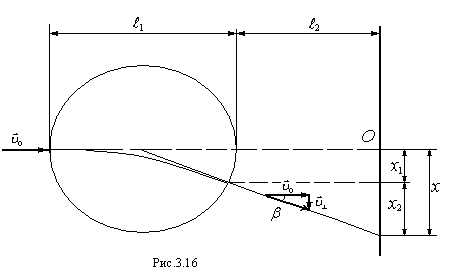 From this expression it follows that the particles, leaving the field, fly as if they had flown out of the center of the capacitor that creates the field at an angle
From this expression it follows that the particles, leaving the field, fly as if they had flown out of the center of the capacitor that creates the field at an angle  .
.
Now suppose that on a length  particle paths are turned on perpendicular to their speed
particle paths are turned on perpendicular to their speed  uniform magnetic field (the field is perpendicular to the plane of Fig. 3.16, the field area is surrounded by a dotted circle). Under the action of the field
uniform magnetic field (the field is perpendicular to the plane of Fig. 3.16, the field area is surrounded by a dotted circle). Under the action of the field
each particle will receive a constant acceleration  . Restricting ourselves to the case when the beam deflection by the field is small, we can assume that the acceleration
. Restricting ourselves to the case when the beam deflection by the field is small, we can assume that the acceleration 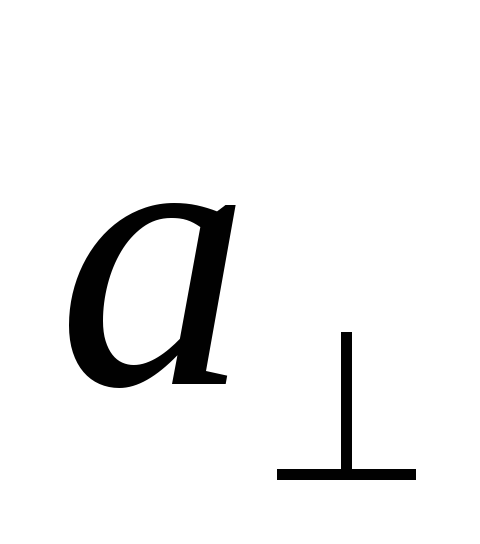 also constant in the direction and perpendicular to
also constant in the direction and perpendicular to  . Then, to calculate the displacement, we can use the formulas we obtained, replacing the acceleration in them
. Then, to calculate the displacement, we can use the formulas we obtained, replacing the acceleration in them  meaning
meaning 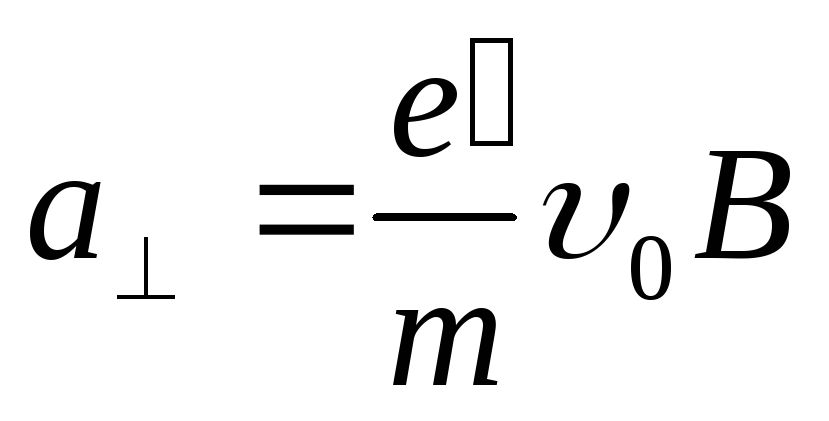 . As a result, for the displacement, which we will now denote by the letter X, we get
. As a result, for the displacement, which we will now denote by the letter X, we get  . The angle by which the beam is deflected by the magnetic field is determined by the expression
. The angle by which the beam is deflected by the magnetic field is determined by the expression  . Then
. Then 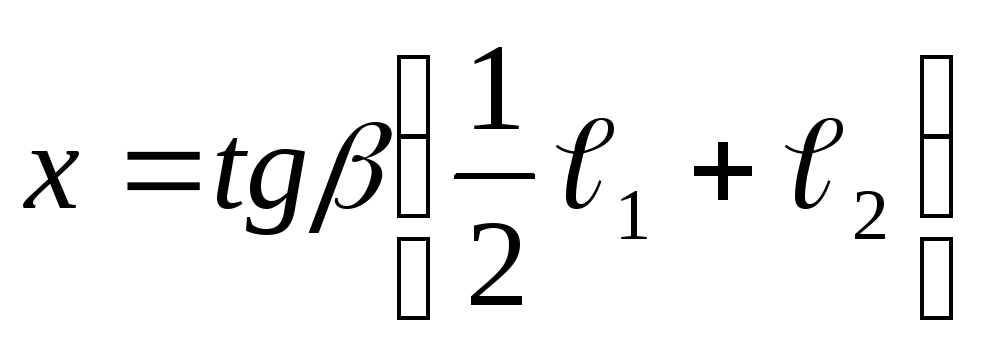 . Consequently, for small deviations, the particles, leaving the magnetic field, fly as if they had flown out of the center of the field at an angle
. Consequently, for small deviations, the particles, leaving the magnetic field, fly as if they had flown out of the center of the field at an angle  . Note that as a deviation at electric field and deflection X magnetic field is proportional to the specific charge of the particles and the intensity (or induction) of the corresponding field. Both deviations also depend on
. Note that as a deviation at electric field and deflection X magnetic field is proportional to the specific charge of the particles and the intensity (or induction) of the corresponding field. Both deviations also depend on  . Particles with the same
. Particles with the same  and
and  receive the same deviation in each of the fields and, therefore, fall into the same point on the screen.
receive the same deviation in each of the fields and, therefore, fall into the same point on the screen.
O  deflection of an electron beam by an electric or magnetic field is used in cathode ray tubes (Fig. 3.17). Inside the tube with electrical deflection, in addition to the so-called electron searchlight, which creates a narrow beam of fast electrons (electron beam), two pairs of mutually perpendicular plates are placed. By applying voltage to any pair of plates, it is possible to cause a proportional displacement of the electron beam in a direction perpendicular to these plates. The screen of the tube is coated with a fluorescent compound. Therefore, at the point where the electron beam hits the screen, a brightly luminous spot appears. Cathode ray tubes are used in oscilloscopes - devices that allow you to observe and photograph fast processes. For one p
deflection of an electron beam by an electric or magnetic field is used in cathode ray tubes (Fig. 3.17). Inside the tube with electrical deflection, in addition to the so-called electron searchlight, which creates a narrow beam of fast electrons (electron beam), two pairs of mutually perpendicular plates are placed. By applying voltage to any pair of plates, it is possible to cause a proportional displacement of the electron beam in a direction perpendicular to these plates. The screen of the tube is coated with a fluorescent compound. Therefore, at the point where the electron beam hits the screen, a brightly luminous spot appears. Cathode ray tubes are used in oscilloscopes - devices that allow you to observe and photograph fast processes. For one p 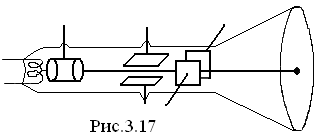 A pair of deflecting plates apply a voltage that varies linearly with time to another pair of voltages under investigation. Due to the negligible inertia of the electron beam, its deviation will follow without delay the changes in voltages on the deflecting plates, and the beam will draw on the oscilloscope screen a graph of the voltage under study versus time. Many non-electric quantities can be converted into electrical voltages (or currents) using appropriate devices (sensors). Therefore, with the help of oscilloscopes, processes of various nature are investigated. The cathode ray tube is an integral part of television devices. In television, tubes with magnetic control of the electron beam are more often used. Instead of deflecting plates, such tubes have two mutually perpendicular coil systems located outside, each of which creates a magnetic field perpendicular to the beam. By changing the current in the coils, they cause the movement of the light spot created by the beam on the screen.
A pair of deflecting plates apply a voltage that varies linearly with time to another pair of voltages under investigation. Due to the negligible inertia of the electron beam, its deviation will follow without delay the changes in voltages on the deflecting plates, and the beam will draw on the oscilloscope screen a graph of the voltage under study versus time. Many non-electric quantities can be converted into electrical voltages (or currents) using appropriate devices (sensors). Therefore, with the help of oscilloscopes, processes of various nature are investigated. The cathode ray tube is an integral part of television devices. In television, tubes with magnetic control of the electron beam are more often used. Instead of deflecting plates, such tubes have two mutually perpendicular coil systems located outside, each of which creates a magnetic field perpendicular to the beam. By changing the current in the coils, they cause the movement of the light spot created by the beam on the screen.
With the simultaneous application of electric and magnetic fields, both fields act independently of each other, so that a wide variety of resulting movements and applications can be obtained. In the simplest case, the forces acting from the electric and magnetic fields cancel each other out. This is how a device is obtained that creates a beam of particles uniform in speed (Fig. 3.18), it is called a speed selector. Let the uniform magnetic field created in the space between the plates be perpendicular to the plane of the pattern. If in e 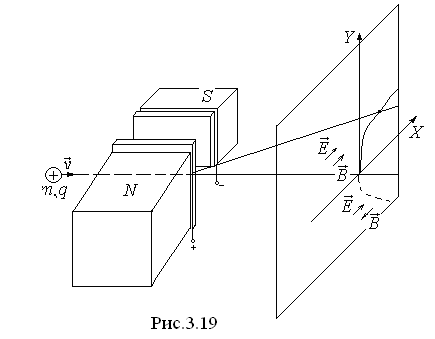 then the space is hit by a beam consisting of particles whose velocities are different, then each particle is affected by the Lawrence force
then the space is hit by a beam consisting of particles whose velocities are different, then each particle is affected by the Lawrence force  . If the particle velocity satisfies the condition
. If the particle velocity satisfies the condition  , then at any time the force is zero, so that the particle passes through the screen aperture D. If the speed of the particle is greater or less than
, then at any time the force is zero, so that the particle passes through the screen aperture D. If the speed of the particle is greater or less than  , the particle is deflected up or down by force and hits the screen D. As a result, to the right of D a beam of particles uniform in velocity will be obtained. Such a device can also be used to measure particle velocity.
, the particle is deflected up or down by force and hits the screen D. As a result, to the right of D a beam of particles uniform in velocity will be obtained. Such a device can also be used to measure particle velocity.
E 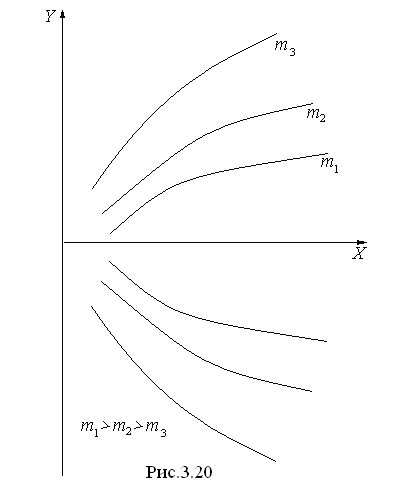 If the electric and magnetic fields are parallel (Fig. 3.19), then the particle deflections caused by the fields are perpendicular to each other, for electric field
If the electric and magnetic fields are parallel (Fig. 3.19), then the particle deflections caused by the fields are perpendicular to each other, for electric field , for magnetic field
, for magnetic field  . Particles with the same specific charge
. Particles with the same specific charge  , fall depending on the speed at different points. These points form a parabola
, fall depending on the speed at different points. These points form a parabola 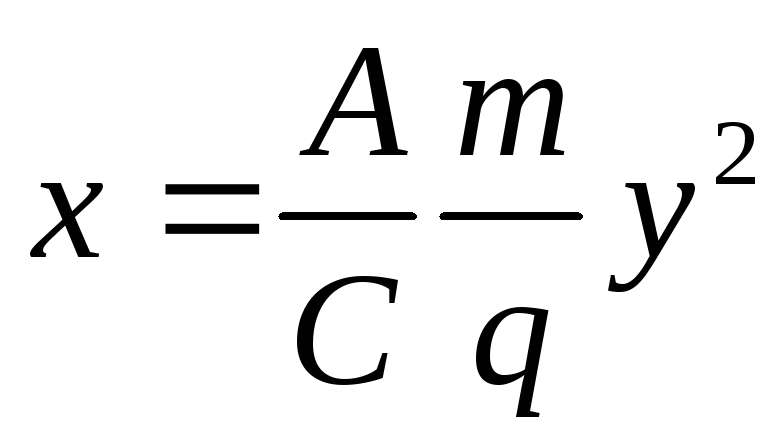 . Quantities BUT and FROM are device constants. Each individual type of ion has its own parabola. Ions that differ from each other and have different velocities are separated in this device, and ions with the same specific charge and any velocity value fall on a separate branch of the parabola, causing blackening on the photographic plate (Fig. 3.20). The operation of a parabolic mass spectrograph is based on this principle.
. Quantities BUT and FROM are device constants. Each individual type of ion has its own parabola. Ions that differ from each other and have different velocities are separated in this device, and ions with the same specific charge and any velocity value fall on a separate branch of the parabola, causing blackening on the photographic plate (Fig. 3.20). The operation of a parabolic mass spectrograph is based on this principle.
Let us consider the motion of particles in simultaneously acting electric and magnetic fields of significant extent. E 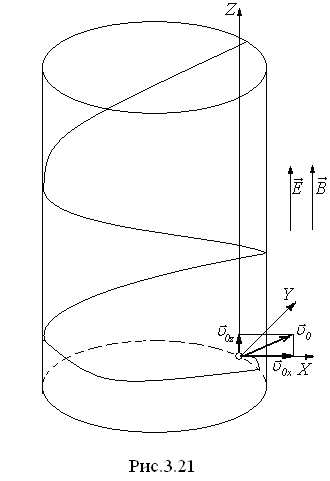 If the particle does not leave the field, but moves constantly in it, then the magnetic field forces it to move in a circle in a plane perpendicular to the direction of the field, and the electric field accelerates it. The result is a helix with increasing pitch (Fig. 3.21).
If the particle does not leave the field, but moves constantly in it, then the magnetic field forces it to move in a circle in a plane perpendicular to the direction of the field, and the electric field accelerates it. The result is a helix with increasing pitch (Fig. 3.21).
H 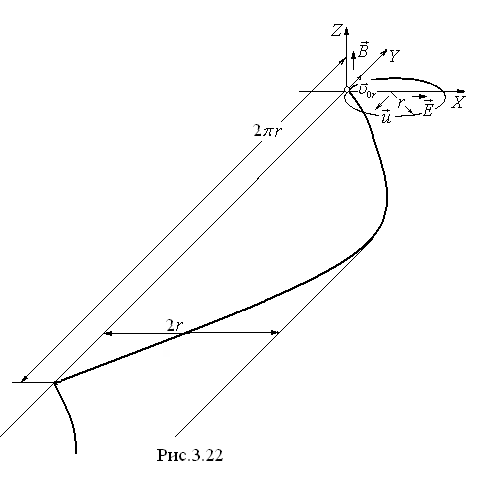 and Fig. 3.22 shows the case when the vectors
and Fig. 3.22 shows the case when the vectors  and
and  are mutually perpendicular, and the particle starts from the origin with an initial velocity equal to zero. The equation of motion in this case is:
are mutually perpendicular, and the particle starts from the origin with an initial velocity equal to zero. The equation of motion in this case is:  . Let's choose new system coordinates, the axes of which at the moment of time
. Let's choose new system coordinates, the axes of which at the moment of time  coincide with the axes of the old system, and the new system moves at a constant speed
coincide with the axes of the old system, and the new system moves at a constant speed  relatively old. The speed of a particle, measured in a fixed coordinate system, at any time is equal to
relatively old. The speed of a particle, measured in a fixed coordinate system, at any time is equal to  , where
, where 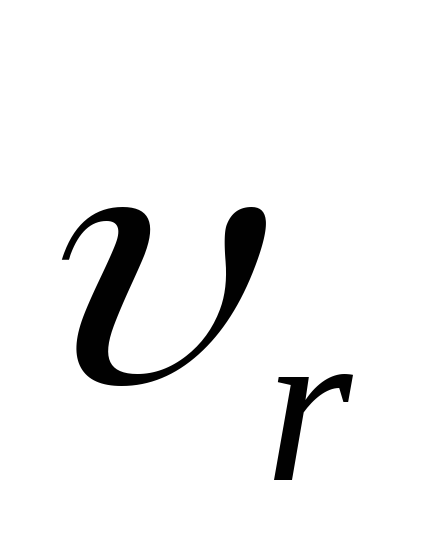 is the speed of the particle in the moving coordinate system. The equation of motion takes the form
is the speed of the particle in the moving coordinate system. The equation of motion takes the form  . Let's choose the speed
. Let's choose the speed  so that
so that  , i.e. speed
, i.e. speed  should be directed against the axis Y and make a difference
should be directed against the axis Y and make a difference 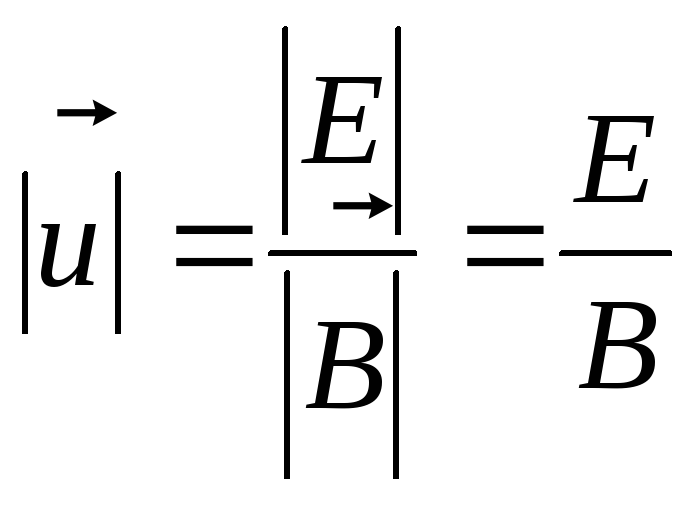 , or
, or  . In a moving frame of reference, the equation of motion takes the form:
. In a moving frame of reference, the equation of motion takes the form:  , since the derivative of the constant
, since the derivative of the constant  equals zero.
equals zero.
A particle in a moving reference frame behaves as if only a magnetic field existed. The effect of the electric field is taken into account by the translational velocity of the reference system. In a moving reference frame, a particle moves in a circle if 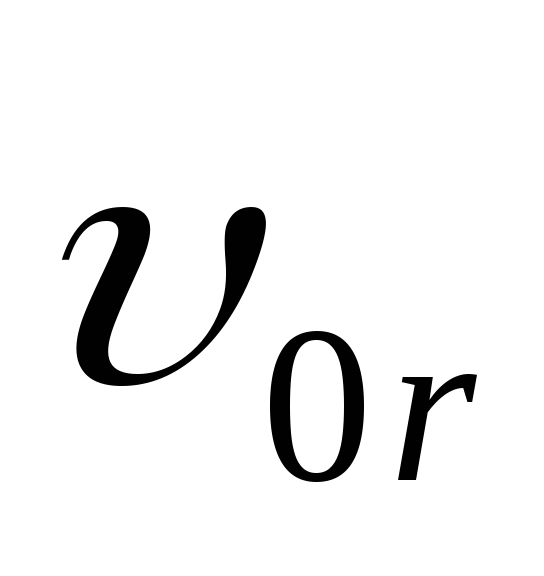 perpendicular to
perpendicular to  , and if the system performs uniform translational motion. Therefore, in the original frame of reference, the trajectory is a cycloid.
, and if the system performs uniform translational motion. Therefore, in the original frame of reference, the trajectory is a cycloid.
Movement of charged particles in mutually perpendicular fields:
trochoid with maximum deflection.
When the magnetic and electric fields differ little from uniform ones, the trajectories of the electrons are close to trochoids. V0 is the electron velocity after entering the anode.
Determination of the specific charge of an electron: determination of the specific charge of an electron by the magnetron method.
As a result of thermionic emission, electrons fly out of the hot cathode and, not reaching the anode, form an electron cloud (space charge) around the cathode. At low anode voltages U anode current strength J increases with increasing voltage. With increasing voltage U the electron cloud around the cathode gradually dissolves, more and more electrons reach the anode, and the current J increases. This regime is called the space charge regime. Starting with some tension U = U us, saturation of the anode current occurs. Having removed the current-voltage characteristic of the diode and determined the value of the coefficient a in the “three second” law: J=aU 3/2, you can calculate the specific charge of an electron using the formula:

The second method of determining the relationship e/m for the electron was called the "magnetron method". This name is due to the fact that the configuration of electric and magnetic fields used in the method resembles the configuration of fields in magnetrons - generators of electromagnetic oscillations in the microwave frequency region.
Cyclotron- a resonant cyclic accelerator of non-relativistic heavy charged particles (protons, ions), in which particles move in a constant and uniform magnetic field, and a high-frequency electric field of a constant frequency is used to accelerate them.
Operating principle:
In the cyclotron, heavy accelerated particles are injected into the chamber near its center. After that, they move inside the cavity of two slightly spaced half-cylinders (dees) placed in a vacuum chamber between the poles of a strong electromagnet. The uniform magnetic field of this electromagnet bends the particle trajectory. The acceleration of moving particles occurs at the moment when they find themselves in the gap between the dees. In this place, they are affected by an electric field created by a high-frequency electric generator, which coincides with the frequency of circulation of particles inside the cyclotron (cyclotron frequency).
Speed selector:
In a number of devices, for example, in mass spectrometers, it is necessary to carry out a preliminary selection of charged particles by velocities. This purpose is served by the so-called speed selectors.
In the simplest velocity selector, charged particles move in crossed uniform electric and magnetic fields. An electric field is created between the plates of a flat capacitor, a magnetic field is created in the gap of an electromagnet. The initial velocity of charged particles is directed perpendicular to the vectors. Two forces act on a charged particle: electrical force qE and Lorentz magnetic force qυB. Under certain conditions, these forces can exactly balance each other. In this case, the charged particle will move uniformly and rectilinearly. After flying through the capacitor, the particle will pass through a small hole in the screen.
The condition of a rectilinear trajectory of a particle does not depend on the charge and mass of the particle, but depends only on its speed:
Mass spectrometers used for the analysis of organic and inorganic compounds. Organic substances for the most part are multicomponent mixtures of individual components. With the help of a mass spectrometer, they find out what these components are and how much of each compound is contained in the mixture.
Principle of operation.
A neutral atom is not affected by electric and magnetic fields. However, if one or more electrons are taken away from it or one or more electrons are added to it, then it will turn into an ion, the nature of the movement of which in these fields will be determined by its mass and charge. Strictly speaking, in mass spectrometers, it is not mass that is determined, but the ratio of mass to charge. If the charge is known, then the mass of the ion is uniquely determined, and hence the mass of the neutral atom and its nucleus.
Stage 1: Ionization
Formation of a positively charged ion by knocking out one or more electrons from an atom (mass spectrometers always work with positive ions).
Stage 2: Acceleration
The ions are accelerated in such a way that they all have the same kinetic energy.
Stage 3: Rejection
The ions are deflected from the trajectory by the magnetic field according to their masses. The lighter the ion, the more it is deflected. The amount of deviation also depends on the number positive charges in an ion - in other words, on how many electrons were knocked out in the first stage. The more the ion is charged, the more it is deflected.
Stage 4: Detection
The ion beam passing through the device is detected by electronic means.
Consider the motion of a charged particle with a charge e and speed v 0 in a uniform electrostatic field with intensity E. If, then the Coulomb force acting on the particle, without changing its direction, only accelerates or slows it down, giving it an additional kinetic energy, determined by the potential difference U:
Let us assume that a particle enters the electric field of a flat capacitor parallel to its plates. (We will assume that the field of the capacitor is homogeneous). Along the axis of the capacitor, the Coulomb force does not act, and the particle retains its initial velocity v x= v 0 . In the perpendicular direction, under the action of the Coulomb force, the particle acquires acceleration and a vertical component of velocity. As a result, the particle in the capacitor moves along a parabola: y~ t 2 , x~ t, Consequently, y ~ x 2 .
After leaving the electric field (from the capacitor), the particle moves uniformly with a speed v at an angle b to the condenser plates. If their length l, then time t can be found from the condition.
Then the speed v is equal to
and angle b is
Consider now the motion of a charged particle with a charge e and speed v 0 in a uniform magnetic field by induction B. If a particle enters this field parallel to its lines of force (), then the magnetic component of the Lorentz force acting on the particle is zero.
If the particle flies in at a speed v 0 into a magnetic field perpendicular to its lines of force, then the magnetic component of the Lorentz force will act on it. This force is directed perpendicular to the velocity vector, that is, the direction of motion, and is a centripetal force. Therefore, the particle will move in a circle. Therefore, the absolute value of the speed of the particle v 0 and its energy will remain constant while moving.
The radius of this circle is determined from the condition:
Thus, the trajectory of a particle in a perpendicular magnetic field has a radius inversely proportional to the specific charge of the particle e/m and magnetic induction B.
The circular motion of charged particles in a magnetic field occurs with a constant period of revolution, independent of their velocities:
The frequency of revolution of a particle in a perpendicular magnetic field is called the cyclotron frequency and is equal to
If a particle flies into a uniform magnetic field with a velocity v 0 at some angle b to the lines of force, then its velocity can be decomposed into two components, one of which v x= v 0 cosb is parallel to the field, and the other v y= v 0 sinb - perpendicular to it. The particle will be affected by the magnetic component of the Lorentz force, due to the perpendicular component of its velocity, that is.
Under its action, the particle will move along a circle of radius with a period of revolution
Parallel to the field velocity component v x= v 0 cosb does not cause the appearance of an additional force, since the magnetic component of the Lorentz force at is equal to zero. Therefore, in the direction of the field, the particle moves by inertia uniformly with a speed v x= v 0 cos. As a result of the addition of both motions, the particle will move along a cylindrical spiral, the radius of which is given above, and the step is equal to






